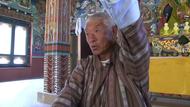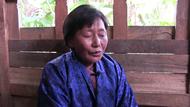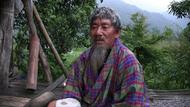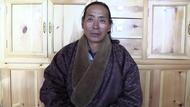Video Overview
Speaker Bio:
Gebchak Wangdrak Rinpoche is the third reincarnation of a Vajrayana yogi who was instrumental in the founding years of Gebchak Nunnery, at the turn of the 19th century. The present Wangdrak Rinpoche became a monk at age 9 (right after the Cultural Revolution) and later earned a Khenpo degree at Dzongsar College in Eastern Tibet. Wangdrak Rinpoche is based in Nangchen on the Tibetan Plateau, where he looks after Gebchak Nunnery and provides facilities for training in Gebchak’s practice system.
- MariaSo, I would like to greet Wangdrak Rinpoché and thanks for joining us today and um… I hope the connection will be OK so we can still talk. And let me introduce, um… I mean you already view the interviews, Wandrak Rinpoché is Lama. He is a lama and abbot… one of the abbots of Gebchak Nunnery, where the nuns doing really, really unique practices. And Elizabeth will be… will be translating and Elizabeth just as I mentioned completed her PhD and she was doing her PhD in mind and body practices with the Gebchak nuns. So, we welcome questions from… from everyone, from audience, and from our… from our participants and panelists to Rinpoché.
- And um… then I will start with the first questions. And so, if Rinpoché can tell us a bit about um… about these body-mind practices that Gebchak nuns are doing. So again they’re very unique because they um… they aim and enhancement of body and mind and interactions. So, interaction between mind and body. So, how… how Rinpoché view these practices in this sense and what are these mind-body practices?
- ཨའེ་ལིས་རྫ་བྷེ་ཐི། (Elizabeth)རིན་པོ་ཆེ་ཁྱེད་ཀྱིས་གསན་ཐུབ་ཀི་འདུག་ཝེ།
- དབང་གྲགས་རིན་པོ་ཆེ།འུམ། ད་ཕལ་ཆེར། ད་དིས་སི་སྒྲ་དེ་གོ་འདུག དིས་སི་གོ་འདུག
- ཨའེ་ལིས་རྫ་བྷེ་ཐི། (Elizabeth)ལགས་སོ། དེ་ནས་དང་པོ་བཀའ་འདྲི་ཞུ་ཡ་དེ། གེ་བཅགས་དགོན་ལ་ད་ཕལ་ཆེར་ཀི་སྒྲུབ་པའི་ཉམས་ལེན་དེ། རྩ་རླུང་ཐིག་ལེ་ལ་བརྟེན་ནས་ཁོ་ཚོ་ཉམས་ལེན་གཙོ་བོ་ག་རེ་བྱེད་བསྡད་ཀི་ཡོད་བ་རེད། དེ་ཚོ་ཀི འུམ་སེམས་ཀི་སྣང་བ། ཡིད་དང་ཡིད་ཆེན་གྱི་སེམས་ཀི་སྣང་བ་དེ་གང་འདྲས་བྱས་ནས་ཤུགས་རྐྱེན་ཐེབས་ཀིན་འདུག
- དབང་གྲགས་རིན་པོ་ཆེ།ད་དེ་རིང་ཁོ་ཚོ་དྲི་བ་གཏོང་མཁན་དང་ཡོངས་རྫོགས་ལ་བཀྲ་ཤིས་བདེ་ལེགས་ཞུ་རོགས་བྱས།
- ElizabethFirst, Rinpoché just says hello, Tashi Delek, greetings to everybody here.
- དབང་གྲགས་རིན་པོ་ཆེ།དེ་ཡིན་དུས། ད་ད་ལྟ་གེ་བཅགས་དགོན་ཀི་ད་དེ་ཟེར་ཀི་ཉམས་ལེན། ད་ཕར་ལོ་རྒྱུས་ལ་ལྟ་ཡོང་དུས་གེ་བཅགས་དགོན་ཀི་རྩ་རླུང་འཕྲུལ་འཁོར་གཙོ་བོ་རྩ་སྒོམ་མཁན་ཞིག གེ་བཅགས་དགོན་པ་རྩ་རླུང་འཕྲུལ་འཁོར་ལ་རྩ་སྒོམ་མཁན་ཀི་དགོན་པ་ཞིག་རེད་ཞ།
- ElizabethMhmm. So, first of all, Gebchak Nunnery was from its establishment, always specializing in the tsa (རྩ།) lung (རླུང་།) type yogas. The tsa lung meaning the, kind of, pradi…prana and nadi, subtle body yogic practices have been their specialty.
- དབང་གྲགས་རིན་པོ་ཆེ།ད་དེ་ཡིན་དུས། ད་སྤྱིར་བཏང་གི་རྩ་རླུང་། ད་དེ་ཡིན་དུས། འུམ། རྩ་རླུང་དེ་ལ་འ། ད་ག་རེ་རེད་ཟེར་དུས། འ་དེ་རིང་ཁ་སང་དེ་ནས་ཡོ་ག་ཟེར་ཡ་ཞིག་རྩེད་ཡ་ཞིག་འདུག་བ། དེ་དང་རྩ་བ་རང་ནས་འདྲ་ཀི་མ་རེད། དངོས་ནས་དེ་ནས་ང་རང་ཚོ་ཀི་རྩ་རླུང་དེ་ཡོ་ག་དེ་དང་རྩ་བ་རང་ནས་འདྲ་ཀི་མ་རེད།
- ElizabethMhmm. And the tsa lung yogas they were doing at Gebchak are not very much at all like the popular yogas that people practice today, not much in common with that.
- དབང་གྲགས་རིན་པོ་ཆེ།དེང་སང་འཛམ་བུ་གླིང་ལ། རྒྱ་ཡིན་ན། རྒྱ་གར་ཡིན་ན། ག་ས་གང་ནས་ཡོ་ག་ཟེར་བ་ཅིག་དེ་ནས་རྩེད་ནས་རྩེད་འདུག དེ་ནས་ཕར་རྩེད་བཞག་ན། དེ་ནས་ལུས་པོ་འཕེན་སྟངས་དང་ལག་པ་གཡུགས་སྟངས་དང་། དེ་ནས་ཕར་བལྟས་བཞག་ན་འདྲ་བོ་ཅིག་ཡོད་བ་རེད་དེ། དེ་ནས་ལྟ་བ་འདྲ་ཀི་མ་རེད། མཐར་ཐུག་གི་འབྲས་བུ་ལ་འདྲ་ཀི་མ་རེད། དམིགས་བསལ་རྦད་མི་ཚད་ཁྱད་པར་ཆེན་པོ་ཡོད་བ་རེད།
- ElizabethMhmm. So if you just observe contemporary yoga, even in India, and you look at the postures and the movements, it can look quite similar to what they’re doing at Gebchak. But when it comes to the inside um…what’s happening in their view, what’s happening in… in… in the mind is quite different.
- དབང་གྲགས་རིན་པོ་ཆེ།གེ་བཅགས་དགོན་པ་ཀི་རྩ་རླུང་དེའི་ནང་ནས་དང་པོ་རྩ་རླུང་ཐིག་ལེ་གསུམ་དེ་ནས་གཙོ་བོ་ལ་དང་པོ་དེ་ནས་གནས་ལ་མཐོང་ཡོང་དུས། ཁོ་རང་གི་དེ་ནས་ཁོ་རང་གི་ལུས་པོ་དང་འཕེན་སྟངས་དེ་ཚོ་ཁོ་ཞོར་ལ་བསམ་བློ་གཏོང་གིན་ཡོད་བ་རེད།
- ElizabethMhmm. So, at Gebchak Nunnery, you know, working with the tsa, and the lung, and the tiklé (ཐིག་ལེ།), these subtle body constituents, really manipulating these and deliberately employing these in their practice, in their meditation, then it’s using these sort of material or outer elements to affect this… this cognitive transformation
- དབང་གྲགས་རིན་པོ་ཆེ།དེ་ཡིན་དུས། ཅིག་མི་མང་པོ་ཞིག་གིས་དེ་ནས་རྩ་རླུང་སྒོམ་ཟེར་དུས། དྲོད་འདྲ་བོ་ཅིག་འབབ་ནས་ལུས་པོ་ལ་དྲོད་འདྲ་བོ་ཅིག་བརྒྱུག་པའི་དམིགས་པ་དེ་རེད་བསམ་ནས། དམིགས་ཡུལ་དེ་རྩ་བ་རང་ནས་མ་རེད།
- ElizabethMhmm. So most people would see tsa lung or tummo practice and think it’s something that brings about inner heat, but that’s not the real purpose. The inner heat is not why they’re doing it.
- དབང་གྲགས་རིན་པོ་ཆེ།དེ་ཡིན་དུས། རྩ་རླུང་ཟེར་ཡ་དེ། ང་རང་ཚོ་ད་ལྟ་ཀི་གནས་ཚུལ་ག་རེ་ཡིན་པ་དེ། བདག་པོ་ཀི་ལུས་ངག་ཡིད་གསུམ། བདག་པོ་ཀི་རྩོལ་བ་ལ་བརྟེན་ནས། བདག་པོ་ཀིས་སྒོམ་ཀི་ལུགས་སྲོལ་དེ་ལ་བརྟེན་ནས་ང་རང་ཚོ་ད་ལྟ་ག་རེ་ཡོད་པ། ད་ལྟ་ག་རེ་ཡོད་པ། དངོས་པོའི་གནས་ཚུལ་དེ་ག་རེ་ཡིན་པ་དེ་དབང་ལ་བསྒྱུར་ཐུབ་ཀི་བསམ་བློ་དེ་རེད་བསྡད་ཡོད་བ་རེད།
- ElizabethMhmm. So their purpose is by again really deliberately manipulating, in a very forceful way, these subtle body elements they’re bringing about um…, you know, an aware… an experience of that… that true nature of reality.
- དབང་གྲགས་རིན་པོ་ཆེ།གང་ལྟར་ཡང་། རྩ་རླུང་ཟེར་ཡ་དང་གསང་སྔགས་རྡོ་རྗེ་ཟེར་ཡ་དེ་སྣང་བ་དབང་དུ་བསྒྱུར་ཡ། སྣང་བ་ཀི་དབང་དུ་བསྒྱུར་ཡ་ཅིག་གི་ཉམས་ལེན་ཞིག་རེད། སྣང་བ་དབང་དུ་བསྒྱུར་ཡ་དེ།
- ElizabethMhmm. In general all Vajrayana practices and yogas are… are trying to transform and… the appearances that are experienced of reality.
- དབང་གྲགས་རིན་པོ་ཆེ།ང་རང་ཚོ་ལ་ཡོད་དང་ཡོད་རྐྱེན་ཞིག་གི་འཛིན་པ་ཞིག་འདུག་བ། ཡོད་བ་འདི་རེད། ཡོད་རྐྱེན་འདི་རེད་བསམ་ནས། དེའི་གཉིས་བར་ན་དེ་ནས་དབང་པོ་ཀི་ཅིག་ཡོད་པ་རེད་དེ་ག་རེ་ཡིན་པ་ཧ་མི་གོ་ཞིག་འབྲེལ་འདུག་མཁན་འདྲ་བོ་ཞིག དེ་ལ་བརྟེན་ནས་འཛིན་པ་མང་པོ་ཞིག་གི་རྣམ་རྟོག་མང་པོ་ཞིག དེ་ནས་དངོས་གནས་ཡོད་བ་དེ་ག་རེ། གནས་ཚུལ་ཡིན་པ་དེ་མཐོང་ཐུབ་ཀི་མི་འདུག དེ་ཡིན་དུས་དེ་ནས་ཞི་གནས་དང་ལྷག་མཐོང་ལ་བརྟེན་ནས་ཡང་། དེ་ནས་དེ་མཐོང་ཐུབ་མི་ཐུབ་ལྟ་ཡ་ཡོད་བ་རེད། དེ་ནས་དེ་ལ་ལྷ་སྦྱོར་བ། དབང་པོ་རྣོན་པོ། དངོས་གནས་ཀི་དེ་ནས་ཚན་རིག་པ་ཁོ་རང་ཚོ་འདྲ་ན་ཅིག་བརྟག་དཔྱད་བཏང་ན། རྦད་མི་སྲིད་ཀི་གསང་སྔགས་རྡོ་རྗེ་ཐེག་པ་དེ་དབང་པོ་རྣོན་པོ་ཀི་ཉམས་ལེན་ཅིག་ཡིན་དུས། དེ་ནས་རྩ་རླུང་གི་ཕན་བརྒྱ་མང་པོ་ཞིག་བཤད་ན། དེ་ལ་ནུས་ཤུགས། བདག་པོ་ཀི་རྩོལ་བ་བརྟེན་ནས་དེ་ནས་ག་རེ་ཡིན་པ་དེ་ག་རང་ལ་དེ་ནས་དངོས་སུ་སྦྱོར་ཐུབ་ཡ་ཅིག་དེ་འདྲ་ཅིག་རེད།
- ElizabethMhmm. So, generally, you know, our mind is… we… but we’re functioning in subject and object. So we know things, we know objects, but somehow that kind of dualistic way of knowing is obscuring the true nature of… of reality, even of the object, because there’s this constant conditioned conceptual interaction with it. So, then the Buddhist approach would be, of course to start with the shamatha and the vipassana meditation training and then, for those who have like, more, kind of, pointed faculties or more heightened intelligence, like maybe scientists and that type that can really, kind of, understand um… these sort of Vajrayana types or the more kind of um… forceful or heightened approach to the nature of reality um… by manipulating the whole mind and body it can bring about a full embodied recognition of the true nature.
- ཨའེ་ལིས་རྫ་བྷེ་ཐི། (Elizabeth)ལགས་སོ་རིན་པོ་ཆེ། དེ་ནས་གེ་བཅགས་ཀི་འུམ་འུམ་
- དབང་གྲགས་རིན་པོ་ཆེ།ད་དེ་དིས་སི་འགྲིག་སོང་།
- ཨའེ་ལིས་རྫ་བྷེ་ཐི། (Elizabeth)ལགས་སོ།།
- ElizabethSo, Maria does that answer the first question? Did you want to ask something else about that first question?
- MariaBecause Rinpoché was mentioning about mind-body practices, right? Of Gebchak Nunnery. So what does it mean mind-body practices exactly? What’s the meaning behind this mind-body practices? Mind and body….
- ཨའེ་ལིས་རྫ་བྷེ་ཐི། (Elizabeth)ད་སྤྱིར་བཏང་ང་ཚོ་དབྱིན་ཇིའི་སྒང་ནས་འགྲེལ་བཤད་བརྒྱབ་ཡོང་ན། གེ་བཅགས་དགོན་ཀི་ཉམས་ལེན་མང་པོ་ཆེ་བ་ཁོང་ཚོ་ལུས་སེམས་འབྲེལ་ལམ་ཀི་སྒོ་ནས་ཟུང་འབྲེལ་ཀི་སྒོ་ནས་ཉམས་ལེན་བྱེད་ཀི་ཡོད་བ་རེད། ཡང་ན་སེམས་རེད། ཡང་ན་གཟུགས་རེད། དེ་འདྲས་ཁོང་ཚོ་ལྟ་ཡ་མི་འདུག་བ། དེ་ནས་གེ་བཅགས་དགོན་ཀི་ཉམས་ལེན་དེ་ཚོ་ལུས་དང་སེམས་ཀྱི་ཟུང་འབྲེལ། ཁོ་ཟུང་འབྲེལ་དེ་ཡུལ་དང་ཡུལ་ཅན་གྱི་ཉམས་མྱོང་ཡིན་ན་འདྲ། ཁོང་ཚོ་ནང་ལོག་གི་འགྱུར་བ་ཐོབ་དུས། ལུས་དང་སེམས་ཀྱི་འབྲེལ་བ་དེ་ག་འདྲས་ཡོད། ག་འདྲས་ཡོད་བ་རེད།
- དབང་གྲགས་རིན་པོ་ཆེ།དེ་དེ་ད་། ད་དེ་རེད། དྲི་བ་ཡག་པོ་ཞིག་དྲིས་སོང་། རེད་རེད། ཡིན་ན་ཡང་། དེ་ནས་ལུས་དང་སེམས་གཉིས་ཀ་དེ་ལུས་སེམས་གཉིས་ཀ་རྩ་རླུང་འཕྲུལ་འཁོར་ལ་བརྟེན་ནས་ཁོ་རང་གི་སོར་དང་རིགས་སུ་ཁྱད་མ་སོང་བྱས་ཏེ། དངོས་པའི་གནས་ཚུལ་དེ་ག་རེ་ཡིན་པ། དེ་ནས། དཔེར་ན། ད་ག་ངས་སྔོན་མ་བཤད་བཞག་ཡོད་བ། དེ་ནས་ཡོ་ག་འདྲ་བོ་ཆ་བཞག་ན། སེམས་ལ་རྩ་བ་རང་ནས་བསམ་བློ་གཏོང་གིན་ཡོད་བ་མ་རེད། ཁོ་རང་ལུས་པོ་ཀི་འཕྲུལ་འཁོར་གཅིག་པོ་སེམས་ཀི་བདེ་ཐང་འདྲ་བོ་བྱས་ན། གེ་བཅགས། གེ་བཅགས་དགོན་པོ་ཀི་ཨ་ནེ་ཐམས་ཅད་ཆ་བཞག་ན། ཁོ་རང་གིས་སོར་དང་རིགས་གཉིས་སུ་ཆད་མ་བཅུག་པ། ཆ་མཉམ་ཡོད་པ་གཅིག་ལ་ལུས་སེམས་གཉིས། དེ་ནས་འུ་འབྲེལ་བ་ཡོད་བ་རེད། དེ་ལ་བརྟེན་ནས་དེ་ནས་དེ་ཟེར་ཀི་ཁོ་རང་གཉིས་མཉམ་དུ་ལ་ཉམས་ལེན་བྱས་ནས་འགྲོ
- ElizabethRight. So, it’s a good question because yeah, the way they approach and experience their practices, yes, they’re mind-body practices so in these Gebchak nuns’ experience it’s not mind or body, one to the exclusion of the other. But, they’re understood as actually the same by the very nature of reality, like in the… the very basic, essential nature of reality, they are not understood as separate. So, like Rinpoché was saying if you observe popular yoga today, it’s a more kind of physical um… fruition, but at Gebchak nunnery that’s… it’s not quite often either body or mind.
- MariaIn contrast to shamatha, right? To vipassana...
- དབང་གྲགས་རིན་པོ་ཆེ།ད་དྲིས་ཤོག་འ། དྲི་བ།
- ElizabethGo ahead Maria.
- MariaI know I just wanted to ask, like shamatha and vipassana would not fall under this category, right? Although they’re also not making distinction between body and mind.
- ཨའེ་ལིས་རྫ་བྷེ་ཐི། (Elizabeth)དེ་ནས་རིན་པོ་ཆེ། གེ་བཅགས་དགོན་འདྲ་བོ་ཆ་བཞག་ན། ཞི་གནས་དང་ལྷག་མཐོང་གཉིས་ཆ་ལ། དེའི་ནང་ལ་ཁོང་ཚོ་མཐོང་གི་འདུག་ཝེ ཁོང་ཚོ་རྩ་རླུང་གི་ཉམས་ལེན་དང་
- དབང་གྲགས་རིན་པོ་ཆེ།མཐོང་། ཡིན་དང་ཡིན། ཞི་གནས་དང་ལྷག་མཐོང་ཆ་ཚང་དེ་གསང་སྔགས་རྡོ་རྗེ་ཐེག་པ་ཀི་ལམ་གཅིག རྩ་རླུང་གི་ནང་ལ་གནས་དེའི་ནང་ལ་བསྡུ་འགྲོ་ཀི་ཡོད་བ་རེད།
- ཨའེ་ལིས་རྫ་བྷེ་ཐི། (Elizabeth)འུ་ནས་ཕལ་ཆེར་སྤྱི་ཡོངས་ཀི་ཞི་གནས་དང་ལྷག་མཐོང་དེ་དང་གསང་སྔགས་རྡོ་རྗེ་ཐེག་པ་ཀི་ཞི་ལྷག་(ཞི་གནས་དང་ལྷག་མཐོང་།)དེ་ལ་ཁྱད་པར་ག་རེ་ཡོད་བ་རེད།
- དབང་གྲགས་རིན་པོ་ཆེ།འེ་དེ་ཡིན་དུས། ཁོ་རང་ཚོ་ལ་དེ་ནས་ནུས་ཤུགས་ཆེ་ཆུང་འདྲ་བོ་སྟོབས་ཆེ་ཆུང་འདྲ་བོ་ཞིག་རེད་མ་གཏོགས་ཞི་གནས་དེའི་ནང་ལ་འདུས་བསྡད་ཡོད་བ་རེད། ལྷག་མཐོང་དེའི་ནང་ལ་འདུས་བསྡད་ཡོད་བ་རེད། ནུས་ཤུགས་རྩ་བ་རང་ནས་འདུས་ཡོད་བ་མ་རེད།
- ཨའེ་ལིས་རྫ་བྷེ་ཐི། (Elizabeth)འུམ་འུམ། འུ་ནས་ནུས་ཤུགས་ཟེར་ཡོང་དུས། གཟུགས་པོ་ཀི་རྩ་དང་རླུང་གི་ནུས་ཤུགས་ལ་གོ་དགོ་ཀི་རེད་ཝེ།
- དབང་གྲགས་རིན་པོ་ཆེ།ཡིན་དང་ཡིན། ང་རང་ཚོ་ཀི་དེ་ནས་ཁོ་རང་ཚོ་ཀི་རྩ་རླུང་འཕྲུལ་འཁོར་དེ་ལ་བརྟེན་ནས་དེ་ནས་སེམས་གནས་ས་ཀི་ཆ་དེ་ལ་ཡོད་བ་རེད། སེམས་གནས་པ་ཙམ་གྱིས་མ་ཚད་པར། དེ་ལ་དེ་ནས་ལྷག་མཐོང་གི་ཆ། སེམས་ཀི་ཆ་དེ་ན་ཡོད་བ་རེད། ཆ་ཚང་དེ་ལ་འཛུལ་བསྡད་ཡོད་བ་རེད།
- ElizabethMhmm. So, first of all, definitely within the, at least the Gebchak Vajrayana tradition that shamatha and vipassana are both very much um… included in their Vajrayana practice. So, um… but the difference with just sort of more Mahayana or exoteric shamatha and vipassana would be again this sort of forceful um… sort of forceful methods of the Vajrayana. So in the tsa lung practices at Gebchak, even, you know, the stability and the concentration that you cultivate in shamatha, they are cultivating that, that one-pointed concentration, but it's through these Vajrayana methods. And then likewise the awareness of the conceptual activity of your mind, that also… but it’s within the… the Vajrayana methods that they’re doing that.
- དབང་གྲགས་རིན་པོ་ཆེ།ད་མདོ་ཀི་སྐབས་སུ་ནས་ཞི་གནས་དང་ལྷག་མཐོང་སྐབས་སུ་ནས། དེ་ནས་ཞི་གནས་སྐབས་སུ་སེམས་གནས་པའི་ཆ་ཙམ། དབུགས་ཙམ་ལ་བསྟེན་ཡ། དེ་ནས་ལྷག་མཐོང་གི་སྐབས་སུ་ནས་མི་རྟག སྡུག་བསྔལ། སྟོང་། བདག་མེད་ད་དེ་ཚོ་བཤད་འགྲོ་ལེ་མ་གཏོགས་བཤད་ཡ་མི་འདུག གསང་སྔགས་རྡོ་རྗེ་ཐེག་པའི་སྐབས་སུ་དེ་མ་ཡིན་པ། ད་ག་རང་། ད་ག་རང་ལ་དེ་ནས་ཐད་ཀར་དུ་ཁོ་རང་དེ་ནས་ག་རེ་ཟེར། ཁྱོད་རང་གི་ལུས་དེ་དག་པ་ཡིན་པ། རྩ་རླུང་ཐིག་གསུམ་གནས་ལ་རྨོངས་ནས་དེ་ནས་དྲག་པོ་ཞིག་རྩོལ་བོའི་སྒོ་ནས་དེ་ནས་ཁྱོད་མི་དག་པ་རེད། སྟོང་བ་རེད། སྡུག་བསྔལ་རེད། ཚོར་བ་རེད། གང་ཡང་བཤད་དགོ་ཀི་མི་འདུག འབྲས་བུ་མངོན་གསལ་ཡིན་དུས། དེ་ག་རང་ཐད་ཀར་དངོས་སུ་སེམས་ལྟ་ཡ་ད་དེ་ཀི་ཁྱད་པར་འདུག
- ElizabethMhmm. So, generally, in the… let’s say exoteric type of shamatha and vipassana, shamatha would be more of a just an abiding. One is cultivating an abiding of the mind, a peaceful abiding often using the breath as the support. And then in… in vipassana maybe really looking to the impermanent nature of… of phenomena and the impurity, the impure nature of phenomena. Whereas in Vajrayana, although they’re also cultivating this abiding, it’s not trying to overcome anything, it’s more direct. So whatever the experiences in the moment, whatever is arising that… that’s it. And um… it’s not trying to shun or… it’s actually engaging, again Rinpoché is saying with… in a forceful, energetic way. It’s… it’s looking right into the essent… the essence of what’s arising, rather than… So it doesn’t look at… look at the impurity and the impermanence as much as the exoteric approach.
- དབང་གྲགས་རིན་པོ་ཆེ།འུམ། དཔེར་ན་མདོ་ཀི་སྐབས་སུ་ནས་ལྷག་མཐོང་གི་སྐབས་སུ་ནས། དེ་ནས་ཁྱོད་རང་ལ་དག་ཡོད་པ་མ་རེད་ཅེས་དག་མེད་པ་བཤད་ཡོང་དུས། རྦད་མི་སྲིད་ཀི་དེ་ལ་ལས་སླ་བོ་ཞིག་མ་རེད། ཕལ་ཆེར་མི་ཐམས་ཅད་ལ་དེ་ནས་གོ་བ་སྤྲོད་ཐུབ་ཡོད་བ་མ་རེད། དག་ཡོད་བ་མ་རེད་དུས། གསང་སྔགས་རྡོ་རྗེ་ཐེག་པའི་སྐབས་སུ་དག་ཡོད་པ་རེད། དེར་མ་ཚད་ཁྱོད་རང་དག་པ་རེད། ལྷ་ཀི་རང་བཞིན་རེད་ཅེས་ངོ་སྤྲོད་ཡོད་དུས། འུ་ནས་ཁོ་རང་ནང་བསྟན་དེ་ག་རང་བྱིན་རླབས་ཐོབ་ཡ་ཡོད་བ་རེད།
- ElizabethMhmm. So, in… like the sutra approach to these meditations and often the stress is on selflessness, one is trying to awaken to selflessness, which, of course, is not a simple thing to understand. You know, most people, we don’t… we don’t recognize that. In the Vajrayana, they also teach one is here to realize selflessness, but selflessness in itself means that yourself is pure, that the teaching almost is divine recognition of… of the very nature of being.
- དབང་གྲགས་རིན་པོ་ཆེ།དེ་ག་ནང་བཞིན་ཀི་ཕྱི་རོལ་ཐམས་ཅད་ཀི་ཁྱེད་རང་མི་དག་པ་རེད་འདྲ་མི་འདྲ། དེ་ནས་མ་དག་པ་རེད་ཅེས་བཤད་ཀིན་ཡོད་བ་མ་རེད། ཕྱི་རོལ་གྱི་ཡོད་ཡོད་ཐམས་ཅད་དག་པའི་རང་བཞིན་རེད། གསང་སྔགས་རྡོ་རྗེ་ཐེག་པ་དེ་ག་རང་ལ་ལྟོས་ཟེར་ནས་ངོ་སྤྲད་ཡོད་བ་རེད།
- ElizabethMhmm. And also with outer objects, so when looking at phenomena it’s not looking at them as impermanent and impure but rather also as pure.
- ཨའེ་ལིས་རྫ་བྷེ་ཐི། (Elizabeth)རིན་པོ་ཆེ། དག་པ་ལབ་ཡོང་དུས་སྟོང་། སྟོང་པ་ཉིད་ལ་གོ་དགོ་ཀི་རེད་ཝེ།
- དབང་གྲགས་རིན་པོ་ཆེ།རེད་རེད། ད་དེ་འདྲ་བོ་རེད། སྟོང་པ་ཉིད་ལ་གོ་དགོ་ཀི་རེད་ཝ།
- ElizabethMhmm. So when Rinpoché’s saying “pure” in the Vajrayana, you look even at objects as pure, Rinpoché almost means like, the empty nature, that empty potential sort of, nature of phenomena.
- དབང་གྲགས་རིན་པོ་ཆེ།སྟོང་པ་ཀི་སྟོང་རྐྱང་མ་ཡིན་པ།
- ElizabethAnd empty meaning not nothing, not an absence.
- དབང་གྲགས་རིན་པོ་ཆེ།དེ་ནས་
- ཨའེ་ལིས་རྫ་བྷེ་ཐི། (Elizabeth)ལགས་སོ།།
- དབང་གྲགས་རིན་པོ་ཆེ།དེ་ནས་མོ་ལ་དྲི་བ་དྲི་རུ་འཇུག་འགྱོ་རེད་བ།
- ElizabethDoes that get at your question about mind and body, Maria?
- MariaYes, absolutely. Yes, thank you, Rinpoché very much. And uh… we welcome question from our panelists and from audience. And in the meantime, I have one more question to ask if it’s OK? I want to ask a question about different, I mean, way of transmitting teaching in Tibet and particularly in Gebchak Nunnery. So, as far as I understand there are textual studies, right? There are really practices, there are transmissions. So, can Rinpoché talk about it, and how… how this particular in Tibetan community, and in particular in Gebchak Nunnery. Like, what kind of teachings are received? Are there textual studies? Or they doing more practices? How is separate one with another?
- ཨའེ་ལིས་རྫ་བྷེ་ཐི། (Elizabeth)Okay, འུ་ནས་རིན་པོ་ཆེ། གེ་བཅགས་དགོན་གྱི་ཁོང་ཚོའི་སྦྱོང་བརྡར། སློབ་སྦྱོང་བྱེད་སྟངས་དེའི་སྐོར་ནས་དིས་སི་གསུང་གནང་རོགས། འུ་ནས་གེ་བཅགས་དགོན་པ་ཁོང་ཚོ་དཔེ་ཁྲིད་དང་ཁྲིད་ཚུལ། གསུང་ཡ་འདྲ་བོ་ཞིག་ཡོད་བ་རེད་ཝེ། ཡང་ན་དབང་རླུང་ཁྲིད་འདྲ་བོ་ཞིག ད་ཁོ་རང་ཚོས་ཤེས་ཡ། ཤེས་བྱ་དེ་ཚོ་གཅིག་གིས་གཅིག་ནས་ག་འདྲས་བྱས་ནས་སྦྱོང་གིན་ཡོད་བ་རེད།
- དབང་གྲགས་རིན་པོ་ཆེ།ད་ཁོང་ཚོ་དང་པོ་ལོ་ཆུང་ཆུང་སྐབས་ཚུར་ཡོང་དུས། དེ་ནས་ཨ་ནེ་ཆེ་ཁ་ཤས་ཤིག་གི་མཉམ་དུ་འདུག་ནས་དེ་ནས་ཆོ་ག ལག་ལེན། ད་དེ་ཚོ་ཀི་ཉམས་མྱིང་མང་པོ་ཞིག་བསགས། དེ་ནས་དེ་ཚོ་ཀི་མདུན་ནས་འདོན་པ་འདོན། དེ་ནས་ཞབས་བརྟན། ཉམས་ལེན་གཟིགས། དེ་ནས་ཡར་ཁོ་རང་ཚོ། ད་མང་པོ་ཞིག་བཤད་ཡ་ཡོད་བ་རེད་དེ། དེ་ཚོ་བཤད་ཡ་དུས་ཚོད་འདང་གི་མི་འདུག དེ་ནས་ད་ག་ལེར་ག་ལེར་བྱས་ནས་མཐའ་མཇུག་སྒྲུབ་ཁང་ལ་འགྲོ་ནས་ད་དེ་ནས་སློབ་སྦྱོང་། སྒྲུབ་ཁང་ནང་ལ་འགྲོ་ཡ་དེ་སློབ་སྦྱོང་རེད་དེ་ཡོད་བ་རེད། བླ་མ་སྤྱིར་བཏང་གི་དེ་ནས་ཁོ་རང་དེ་ནས་གདམས་ངག་གི་ལྟར་དུ། མན་ངག་གི་ལྟར་དུ། དེ་ནས་ཁོ་རང་ཚོ་ལ་འཁྲིད་སྟངས་བཤད་ཡ་དང་། ཁོ་རང་ཚོ་ལ་ཉམས་མྱོང་བཤད་ཡ་དང་། གཅིག་གཅིག་ལ་དེ་ག་རང་ནས། ཨ་ནེ། རྒན་པ་དེ་ཚོས་གཞོན་པ་དེ་ཚོ་ལ་ཁོ་རང་ཚོ་ཀི་ཉམས་མྱོང་ག་རེ་ཡོད་པ་དེ་ཨམ་འཇོག་ནང་ལ་དེ་ནས་སློབ་སྦྱོང་བཤད། དེ་ནས་དེ་དང་མཉམ་དུ་བླ་མས་མན་ངག་སྦྱིན། དེ་ནས་ཁོ་རང་ཚོ་རྩ་རླུང་འཕྲུལ་འཁོར་དེ་ཚོ་སྦྱངས་ནས། ད་གཙོ་ཆེ་བ་དེ་ཚོ་ཡོད་བ་རེད།
- ElizabethOK. So mostly at Gebchak nunnery, the nuns traditionally would join fairly young and they would start by learning the different rituals, even some artistic rituals, and… and learn reading and there’s uh… lots of things they’d have to spend their time learning to be able to engage in the ceremonies. And then after a few years, then they would start their first three-year retreat. And the retreat Rinpoché said we could consider a study of sorts, as… as learning, but mainly it’s… the learning happens through the personalized, pith instruction. And often in the retreat center, it’s those older nuns that they’re, you know, delivering and sharing their practice… their experience… experiential knowledge of the practices to the younger nuns, and then the nuns… the younger nuns sort of carry them out and demonstrate their understanding. So it’s very much a practical learning style of these yogas and practices.
- ཨའེ་ལིས་རྫ་བྷེ་ཐི། (Elizabeth)འུ་ནས་རིན་པོ་ཆེ། ཡི་གེ་ དཔེ་ཆ་མང་པོ། འདོན་འདོན་པ་མང་པོ་འདོན་དགོ་ཀི་ཡོད་བ་རེད། གེ་བཅགས་དགོན་པ་ལ། ཡི་གེ་མང་པོ་ཀློག་གི་རེད་ཝེ།
- དབང་གྲགས་རིན་པོ་ཆེ།ཡི་གེ་མང་པོ་ཀློག བཀའ་འགྱུར་འདྲ་བོ་ཀློག་ཡ་དེ་འདྲ་ཞིག་མ་རེད། ཁོ་རང་ཚོ་དེ་ནས་སྒྲུབ་བ་ཞིག་ཚོགས། སྒྲུབ་ཆེན་གྱི་ནང་ནས་དེ་ནས་ཆ་ཚང་སྐྱབས་འགྲོ་དང་སེམས་སྐྱེད་དང་། ཆ་ཚང་ཡོད་བ་རེད་དེ། གེ་བཅགས་ཀི་ཨ་ནེ་ལ་ཁྱད་ཆོས་ག་རེ་ཡོད་བ་རེད་ཟེར་དུས། ང་རང་གི་སེམས་དེ་ནས་བདག་པོ་ཀི་ངོ་བོ་ཤེས། སེམས་དེ་ཉིད་ཀྱི་དབང་བསྒྱུར་ཤེས་ན། ཚུར་གྱི་ཡོད་དེ་གཙོ་བོ་རེད་མི་འདུག ནང་གི་སེམས་དེ་ཀིས་ཕར་ཡོད་བསྡད་པ་དེ་དབང་བསྒྱུར་རྒྱུ་རེད་མ་གཏོགས།་ཚུར་རོལ་གྱི་གཟུགས་ཀིས་དེ་ནས་ང་རང་ལ་དབང་བསྒྱུར་མི་འདུག་བ་དེ་ཧ་གོ་ཀི་རེད།
- ཨའེ་ལིས་རྫ་བྷེ་ཐི། (Elizabeth)ལགས་སོ།།
- ElizabethSo, at Gebchak Nunnery they do read a lot of texts every day. Um… But the way they read it’s not… it’s nothing like just reciting sutras, it’s not just mere recitation, but most of their reading happens in these drupchens (སྒྲུབ་ཆེན།), which are these extended maybe 10 day long collective sadhana practices, so tantric ritual ceremonies. And so all the reading that they’re doing and all the practical learning that they’re doing ultimately is to understand how their mind is the creator. And so that the mind… that the accomplishment is when they realize their mind is the master of appearances, and appearances meaning the way we experience reality. That’s the whole point of their reading and….
- དབང་གྲགས་རིན་པོ་ཆེ།བདེ་སྡུག་དང་། ཚོར་བ་ཡོངས་རྫོགས་སེམས་ལ་ཕོག་འགྲོ་བ་ཧ་གོ སེམས་དེ་ཉིད་ཀིས་ཕར་དབང་བསྒྱུར་ཐུབ་ཡ་ཧ་གོ ད་དེ་འདྲ་ཅིག དེ་ནས་གེ་བཅགས་པ་ཀིས་དེ་ནས་སྒྲུབ་ཆེན་མང་པོ་ཞིག་ཚོགས་བསྡད་ཡོད་བ་རེད། སྒྲུབ་ཆེན་ཏེ། བསྐྱེད་རིམ། རྫོགས་རིམ། རྫོགས་རིམ་ཀི་དེ་ནས་མཚན་བསྐྱེད་དང་མཚན་མེད། དེ་ནས་མཐའ་མ་དེ་སྒྲུབ་སྟངས་ཀྱི་བསྐྱེད་པ་དེའི་ནང་ལ་ཆ་ཚང་ཚང་བསྡད་ཡོད་བ་རེད།
- ElizabethSo their… the goal is to… to understand how all the suffering and the… the happiness of life is really, it comes down to the mind. The mind creates that. And so that it’s not the outer world that influences oneself but rather one’s own mind is the master of the outer world. Umm… And they do this through, you know, the Vajrayana path of generation stage and completion stage and then the yogas of the completion stage with characteristics and the completion stage without characteristics and the dzokchen (རྫོགས་ཆེན།) meditation and so forth.
- དབང་གྲགས་རིན་པོ་ཆེ།དེ་ཡིན་དུས། ད་གང་ལྟར་ཡང་། གསང་སྔགས་རྡོ་རྗེ་ཐེག་པའི་ཉམས་ལེན་ཟེར་ཡ་དེ། དེ་ནས་མ་དག་པ་སྣང་བ་ཐམས་ཅན་དག་པ་ཀི་སྣང་བ་ལ་བསྒྱུར་ཐུབ་ཡ། དངོས་པོའི་གནས་ཚུལ་ག་རེ་ཡིན་པ་དེའི་སྟེང་ལ་འགྲོ་ཐུབ་ཡ། ད་དེ་རེད་བསྡད་ཡོད་བ་རེད།
- ElizabethSo, in a nutshell, the kind of, Vajrayana definition of what they’re learning is to transform all impure experience into pure experience.
- དབང་གྲགས་རིན་པོ་ཆེ།ད་དེ་ཡིན་དུས། ཚན་རིག་པ་ཐམས་ཅད་ཀིས་སྟོང་ཉིད་དེ་མཐོང་བསྡད་ཡོད་བ་རེད། སྟོང་ཉིད་དེ་མཐོང་བསྡད་ཡོད་བ་རེད། སྟོང་ཉིད་མཐོང་བསྡད་ཡོད་བ་རེད་ཟེར། སྟོང་ཉིད་དེ་མཐོང་བསྡད་ཡོད་བ་རེད། ཡིན་ན་ཡང་སྟོང་ཉིད་དེ་དེ་ནས་མང་པོ་ཞིག་གོམས་འདྲེས་ལེན་ནས། སྟོང་ཉིད་དེ་རྟོགས་ཐུབ་ཡོད་མ་རེད་དེ། ཁྱེད་རང་ཚོ་ཆ་ཚང་གིས་སྟོང་ཉིད་དེ་མཐོང་ཐུབ་ཀིན་འདུག་ཝ།
- ཨའེ་ལིས་རྫ་བྷེ་ཐི། (Elizabeth)འུམ། འུམ། ལགས་སོ།།
- ElizabethRinpoché is saying that, you know, much of science nowadays has actually understood… comprehended emptiness um… and can explain that. But it doesn’t mean that… that we’ve experientially understood it. We haven’t realized it.
- དབང་གྲགས་རིན་པོ་ཆེ།ང་རང་ཚོ་ཀི་སྣང་བ། དབང་སྒྱུར་ཀི་གདམས་ངག གསང་སྔགས་རྡོ་རྗེ་ཐེག་པའི་ཁྱད་ཆོས་ཏེ། དེ་ནས་ཁྱེད་རང་ཚོས་རྦ་རླབས་སྟེང་ནས་ལས་ཀ་ལས་ནས་དབྱིན་ཇིའི་སྟེང་ནས་ཕར་ཚུར་འབྲེལ་བ་གནང་ཡ་དེ་གཅིག་པ་གཅིག་རྐྱང་རེད། གཅིག་པ་གཅིག་རྐྱང་དེ་ག་རང་རེད།
- ElizabethAnd Rinpoché is uh… saying that when he talks about the mind becoming a master of reality, really it’s… it’s very much similar to the kind of modern quantum physics idea of waves and particles and how form um… manifests, and so forth.
- དབང་གྲགས་རིན་པོ་ཆེ།ང་ཚོ་ཁང་བ་ཆུང་ཆུང་། ཁང་བ་ཆུང་ཆུང་ཞིག་གི་ནང་ལ། ཁང་བ་ཆུང་ཆུང་ནང་ལ་འཛམ་བུ་གླིང་གི་བཀོད་པ་ཆ་ཚང་འཆར་ཐུབ་ཡོད་བ་རེད། ཚང་ཐུབ་ཡོད་བ་རེད།
- ElizabethThat it’s possible within a small room for the entire universe to be experienced by somebody.
- དབང་གྲགས་རིན་པོ་ཆེ།ཧ་ཧ་ཧ། ཧ་ཧ་ཧ་ཧ། ཧི་ཧི་ཧི། འུ་ནས་གོ་སོང་ཝེ།
- ཨའེ་ལིས་རྫ་བྷེ་ཐི། (Elizabeth)གོ་སོང་ལགས།
- དབང་གྲགས་རིན་པོ་ཆེ།བྲག་ཕུག་ཆུང་ཆུང་དེའི་ནང་ལ་རྣལ་འབྱོར་བ་ཁོ་རང་ཚོ་བྲག་ཕུག་ཆུང་ཆུང་དེའི་ནང་ལ་རྩམ་པ་དེ་ཟ་ནས་བསྡད་སྡོད་ཡོད་བ་རེད། ཡིན་ན་ཡང་། འཛམ་བུ་གླིང་གི་བདེ་བ་དང་། འཛམ་བུ་གླིང་གི་ག་འདྲ་ཡོད་པ་ཆ་ཚང་ཁོ་རང་ཚོ་ཀི་དེ་ནས་བྲག་ཕུག་ནང་ལ་མཐོང་ཐུབ་ཀི་ཡོད་བ་རེད།
- ElizabethSome of these yogis in Tibet, staying in a small cave and just eating their… their roasted barley flour they could have this quite um… fantastic, you know, experience of the whole cosmos.
- དབང་གྲགས་རིན་པོ་ཆེ།དེ་ནས་
- MariaAnd we have a question. We have a question from Laurence. (laughter)
- LaurenceFirst of all, thank you very much uh… for all of that um… that insight into the practices in… in uh… in the nunnery. The question I want to ask is whether sometimes, some people or perhaps many or a few end up having a lot of difficulty at a certain point in their practice, to the point that they become very distressed and they… they can’t continue, or it seems like that and… and how you deal with that if it if that happens how you deal with that?
- ElizabethMhmm. So, you mean at… like at Gebchak Nunnery? Or in Tibet? At Gebchak nunnery, right.
- LaurenceYeah.
- ཨའེ་ལིས་རྫ་བྷེ་ཐི། (Elizabeth)རིན་པོ་ཆེ། དེ་ནས་ཕལ་ཆེར་ཁམས་ནང་ཆེན། སྤྱིར་བཏང་ཁམས་ནང་ཆེན་དང་། ལྷག་པར་དུ་གེ་བཅགས་དགོན་ཀི་སྤྱི་ཚོགས་ནང་ལོག་ལ། སྐབས་སྐབས་ཁོ་ཚོ་དྲག་པའི་ཐབས་ལམ་ལ་ཁོ་ཚོ་ཉམས་ལེན་འདྲ་མི་འདྲ་བྱེད་ཀིན་ཡོད་བ་རེད། ཡིན་ནེ་སྐབས་སྐབས་ལ་མི་དེ་ཚོ་སེམས་ལ་དཀའ་ངལ་འཕྲད་ཀི་ཡོད་བ་རེད་ཝེ། དཔེར་ན། སེམས་འཚུབ་བྱེད་ཡ་དང་། དངངས་སྐྲག་སྐྱེས་ཡ་དང་། ཁོང་ཚོ་ཐུགས་སྣང་མང་པོ་ཤར་ཡ་དང་། ག་རེ་ཟེར། སེམས་ཐང་ཐང་མེད་འགྱོ་འདྲ་བོ་ཆགས། ཆགས་ཀི་རེད་ཝེ།
- དབང་གྲགས་རིན་པོ་ཆེ།གེ་བཅགས་དགོན་ལ་དེ་འདྲ་ཀི་བྱུང་མྱོང་མི་འདུག ཐང་ཐང་མེད་འགྱོ་དང་། དེང་སེང་འཛམ་བུ་གླིང་ལ་དེ་ནས་ན་ཚ་འདྲ་མི་འདྲ་མང་པོ་བྱུང་གིན་འདུག་སྟེ་དེ་ཚོ་བྱུང་གིན་མི་འདུག དེ་ག་རེ་རེད་ཟེར་ན། དེ་ནས་བླ་མ་ཀི་མན་ངག གསང་བ་དེ་ཤིན་ཏུ་ཁོ་རང་། དིས་སི་དེ་ནས་དེ་ལ་བདག་པོ་ཡག་པོ་ཅིག་ཕོགས། དེ་ལ་དབང་བསྒྱུར་བྱས། དེ་ནས་ལྷག་རླུང་དབང་སྒྱུར་ཀི དེ་ནས་ལྷག་རླུང་དབང་སྒྱུར་ཀི དེ་ནས་གཏིང་མ་ཡག་པོ་ཞིག་ཡོད་ན། དེ་ཀི་དེ་ནས་དེ་བཟོ་ཀི་མི་འདུག མང་ཆེ་ཤོས་དེ་སྣང་བ་དགྲ་ཀིས་བླངས་ཟེར་ནས། མང་ཆེ་ཤོས་སྣང་བ་དགྲ་ཀིས་བླངས་ནས། རྒྱུ་མཚན་དེ་ལ་བརྟེན་ནས། དེ་ནས་མང་པོ་ཞིག་སྙུང་འགྲོ་ཡ། སེམས་མ་སྐྱིད་པ། འདྲ་མི་འདྲ་ཞིག་གནས་ཚུལ་དེ་ལ་ཐུག་བསྡད་ཡོད་བ་རེད། དེ་ག་ཐམས་ཅད་སྔ་ས་ནས་བླ་མ་ཀི་མན་ངག་ནང་ལ། མན་ངག་དང་གདམས་ངག་ནང་ནས་དེ་ཚོ་ལ་ཁོ་རང་ཚོ་ལ་སྔ་ས་ནས་ངོ་སྤྲད། དེའི་སྐབས་སུ་དེ་འདྲ་འགྲོ་དགོ་ན། སྣང་བ་དེ་རེད་དེ་རེད་ཟེར་ནས་ངོ་སྤྲད་པའི་རྒྱུ་མཚན་ལ་བརྟེན་ནས་དཀའ་ངལ་ཡོང་གིན་མི་འདུག
- ElizabethMhmm. So, I’ll just answer the first part and then ask what they do if it happens in the second. And first of all, at Gebchak Nunnery um… they don’t… they haven’t had any experience of like serious psychosis and the kind of problem of not being able to sleep well, he’s telling me that sort of thing doesn’t… doesn’t happen really at Gebchak. And Rinpoché feels the main reason for that is because they have a… a very much an intact system of the pith instructions, so a lot of qualified practitioners around them that can constantly be there to point out what’s happen… you know, the appearances that people are experiencing. So they would say when psychosis happens or an unhappy mind happens, they would say “nangwa drayi langwa” (སྣང་བ་དགྲ་ཡིས་བླངས་བ།) which means the appearances in your mind, the conceptual activity in your mind, you project it outside so it becomes an external enemy. So they’ve got a lot of qualified mentors around to be there for the individual, to be pointing out and to be interacting with them, to guide him through those mental experiences, then that’s… that usually kind of preempts there being a lot of problems.
- ཨའེ་ལིས་རྫ་བྷེ་ཐི། (Elizabeth)དེ་ནས། གལ་སྲིད་དེ་འདྲས་ཐང་ཐང་མེད་འགྱོ་འདྲ་བོ་ཅིག སྡུག་ཆ་ཅིག་ཆགས་སོང་ན། ཁྱེད་རྣམ་པ་སྙེན་པ་ག་རེ་སྦྱོར་ཀི་རེད། རིན་པོ་ཆེ།
- དབང་གྲགས་རིན་པོ་ཆེ།འོ་ད་དེ་ཚོ་ལ། ཁོ་རང་ཚོ་རྦད། དེའང་ལོག་ག་ཅིག་རེད། ཁ་ཕྱེད་ཅིག་དེ་འདྲས་ཅིག་གི་ན་ཚ་འདྲ་བོ་ཅིག་རེད་མ་གཏོགས། སེམས་ཐང་ཐང་མེད་འགྱོ་དང་སེམས་འདྲ་མི་འདྲ་དེ་དངོས་ནས་དྲང་ནས་རྩ་བ་རང་ནས་ཡོད་བ་མ་རེད། སེམས་ཐང་ཐང་མེད་འགྱོ། སེམས་ཐང་ཐང་མེད་འགྱོ་གེ་བཅགས་དགོན་ལ་ཟེར་ཡོང་དུས། ཁོ་རང་ཚོ་དེ་ནས་གདམས་ངག་དེ་ཚོ་ངོ་སྤྲད། སྣང་བ་དབང་སྒྱུར་ཀི་གདམས་ངག་དེ་ཚོ་ངོ་སྤྲད། ང་རང་གི་སྣང་བ་འཕྲུལ་སྣང་ཡིན་པ་ངོ་སྤྲད། ཁ་ཕྱེད་ཅིག་གིས་དེ་ནས་འདྲ་མི་འདྲ་ཅིག་ཅིག་འདྲ་མི་འདྲ་བཤད་ན། སྣང་བ་དབང་སྒྱུར་ལ་ངོ་སྤྲད་ན་བརྒྱ་ཆ་བརྒྱ་ཕན་ཐོག་གི་འདུག
- ElizabethMhmm. So generally…
- དབང་གྲགས་རིན་པོ་ཆེ།སྣང་བ་དབང་སྒྱུར་ཀི་གདམས་ངག་ཡག་པོ་ཡོད་བ་རེད།
- ElizabethMhmm. Yeah, so Rinpoché’s answer here is pretty much the same that really you don’t… you don’t really see extreme psychosis happening as a result of the practices. And in some cases maybe some women are joining the nunnery with unstable minds, I’ve actually seen two where they joined and maybe their minds aren’t very stable but then um… over time as they engage with the community and they get a lot of guidance from again qualified mentors, so that they’re able to really, really work with what’s happening in their minds. And they tend to heal.
- དབང་གྲགས་རིན་པོ་ཆེ།འུམ། དེ་ཡིན་དུས། ད་དེ་ཚོ་ལ་གདམས་ངག་མང་པོ་ཞིག་ངོ་ནས་ཀི་གསང་སྔགས་ཀི་ཁྱད་ཆོས་མང་པོ་ཞིག་བཤད་ཡ་ཡོད་བ་རེད། དེ་ནས་དེ་རིང་ཁ་སང་འཛམ་བུ་གླིང་གི་མི་མང་ཆེ་ཤོས་ཤིག སྣང་ཆུང་ནང་གིས་དགྲ་ཐུག་སོང་། ཅིག་མཐོང་སོང་། ཅིག་གཟིགས་སོང་། འདྲ་མི་འདྲ་རིག་སོང་། ཅིག་མེད། རླུང་མེད་སོང་། དེ་ཚོ་ཐམས་ཅད་ཚུར་ལ་དབང་སྒྱུར་ནས་ཡོད་བ་རེད། སྣང་བ་དགྲ་ཀིས་བླངས་བ་རེད། དེ་ཚོ་ལ་ཕར་ལ་སྣང་བ་ཀིས་དབང་སྒྱུར་ཐུབ་པ་དགོ་ཀི་ཡོད་བ་རེད། དེ་ཚོ་ཐམས་ཅད་ཆ་ཚང་དེ་ནས་རྐྱེན་ངན་མང་དུ་བསྒྱུར་ཐུབ་ཡ། སེམས་ཀྱི་རྩལ་ཡིན་པ། རིག་པའི་རྩལ་ཡིན་པ་ཧ་གོ་ཐུབ་ཀི་ཡོད་བ་རེད། དེ་ནས་རྦད་མི་སྲིད་པའི་ཡག་པོ་ཡོད་བ་རེད། ཉམས་ལེན།
- ElizabethSo, actually talking about the instructions like the way that teaching occurs in a Vajrayana community is really quite um… um… important because, you know, nowadays most education happens through… you know, we read a lot, and we see a lot, and we hear a lot, and we… we accumulate a lot of information and it fills our minds. So it’s almost like something from the outside that then influences us. But, of course, the Vajrayana approach is much more um… much… the subject and object isn’t so separate so that it’s really entailing the… the very nature of the knowing mind. And Rinpoché is saying “rigpé tsel” (རིག་པའི་རྩལ།) and “sem kyi tsel” (སེམས་ཀྱི་རྩལ།), so “tsel” is the word for… you can translate that as energy, or creative expression. So it’s this really kind of energetic creative aspect of the knowing mind that is triggered and involved in this exchange.
- དབང་གྲགས་རིན་པོ་ཆེ།རིག་པའི་རྩལ་ཟེར་ཡ་དང་། ངས་ད་ག་སྣང་བ་དབང་སྒྱུར་བྱེད་ཡ་དེ་ཚོ་ག་རེ་རེད་ཟེར་ན། ང་ཚོ་ཆ་ཚང་ལ་ཡོད་བ་རེད། འཛམ་བུ་གླིང་མི་ཆ་ཚང་ལ་ཡོད་བ་རེད། ཕོ་ལ་ཡོད་བ་རེད། ཕོ་མོ་ལ་ཡོད་བ་རེད། ཆ་ཚང་ལ་ཡོད་བ་རེད།
- ElizabethMhmm. And Rinpoché keeps saying about um… becoming a master of appearances so that the mind is the creator, the mind is known as the master of one’s experience. So reality as we know it, that that’s available to us now, to men, women, whoever we are, wherever we are, that’s something that’s… that’s… you know, it’s the potential for each of us right now, the nature of mind.
- དབང་གྲགས་རིན་པོ་ཆེ།ང་རང་ཚོ་ཀི་དངོས་པོའི་གནས་ཚུལ། ང་རང་ཚོ་ཀི་དངོས་པོའི་གནས་ཚུལ་ད་ལྟ་ངས་མཐོང་བཞིན་པའི་དངོས་པོའི་གནས་ཚུལ་དེ་ངོ་ནས་ཀི་ཁོ་རང་། ད་ག་རང་། ད་ག་རང་དངོས་པོའི་གནས་ཚུལ་ག་རེ་ཡིན་པ་དེ་མཐོང་ཐུབ། ཕྱིན་ཅི་མ་ལོག་པ་རྟོགས་ཐུབ་ན། ང་རང་ཚོ་ཀི་དམིགས་ཡུལ་དེ་སངས་རྒྱས་ཀྱི་གོ་འཕངས་ཐོབ་ཡ་དེ་དེ་རེད།
- ElizabethSo it’s really about truly knowing the nature of reality without any obscuration. That's really the whole point and that’s the meaning of buddhahood in their tradition.
- དབང་གྲགས་རིན་པོ་ཆེ།དེ་ཡིན་དུས། འཛམ་བུ་གླིང་གི་དེ་ནས་ད་རང་དེ་ནས་གཟུགས་ཐམས་ཅད། ཁ་མདོག་ལ་སོགས་པ་ཐམས་ཅད་གཟུགས་མི་གདའ། བདེན་པ་རེད་མི་གདའ། སྟོང་པ་རེད་གདའ་ཁྱེད་རང་ཚོ་ཀིས་དེ་ནས་ཧ་གོ་འདུག་བ། ཡིན་ན་ཡང་། སྟོང་པ་དེ་ལ་བརྟེན་ནས་ང་རང་གི་ནང་ལ་ཡོད་པ་ཀི་དེ་ནས་ཏིང་འཛིན་དང་ཞེན་ཆགས་དེ་ཚོ་རྟོགས་ཐུབ་ཀི་མི་འདུག་བ། དཀའ་ངལ་དེ་རེད།
- ElizabethYou know so Buddhism of course is teaching that… that the relative appearances are created by the mind. So shapes and colors, this is something that, you know, even neuroscience understands about how, you know, color doesn’t exist in the object, it's something that our mind creates. So we understand that conce…. intellectually um… but we still have this habit, this conceptual fixation on believing it to be real.
- དབང་གྲགས་རིན་པོ་ཆེ།དཔེར་ན། ངས་དཔེ་ཞིག་བཞག་དགོ་འ། དཔེ་ཞིག་བཞག་དགོ དཔེར་ན། སྒྱུ་མ་འཕྲུལ་མཁན་གིས། ང་ལ་སྒྱུ་མ་འཕྲུལ་ཐུབ་མཁན་ཞིག་གིས་བུད་མེད་མཛེས་མ་ཞིག་ཕར་ཀ་ལ་ཕར་འཕྲུལ། ང་རང་གི་རྟོགས་བསྡད་ཡོད། ཁོ་བདེན་པ་མ་ཡིན་པ་ཤེས་ཡོད། ཡིན་ན་ཡང་སེམས་ཀི་འདུ་ཤེས་དེ་ཁོ་རང་ལ་ཆགས་འགྲོ་ཀི་ཡོད་བ་རེད།
- ElizabethSo, one example is if you are a magician and you could create a mirage, a very realistic looking mirage of a beautiful woman, even the magician might create that mirage, but it can look so real and so beautiful that even he would become attached to the mirage. It’s much like, the way our minds work.
- དབང་གྲགས་རིན་པོ་ཆེ།ཧི་ཧི་ཧི། ཧ་ཧ་ཧ་
- དབང་གྲགས་རིན་པོ་ཆེ།དངོས་ནས་ཡིན་ན་ཁོ་རང་གིས་འཕྲུལ་བ། ཁོ་རང་གིས་འཕྲུལ་བསྡད་ཡོད་བ་རེད། རྫུན་མ་རེད་བ། རྫུན་མ་དེ་ལ་ཁོ་རང་ཆགས་འགྲོ་ཀི་ཡོད་བ་རེད། ང་རང་ཚོ་དེ་ནང་བཞིན་ཆགས་འགྲོ་ཀི་ཡོད་བ་རེད། ཧ་ཧ་ཧ་
- ElizabethSo it’s, in fact, the magician created that mirage and it’s not really existing out there at all and he kind of knows that but still he’s engaging with it like it’s real. That’s how our ordinary minds work.
- དབང་གྲགས་རིན་པོ་ཆེ།ཧུ་ཧུ་ཧུ། ་ཧུ་ཧུ་ཧུ་ཧུ་ཧུ་
- ཨའེ་ལིས་རྫ་བྷེ་ཐི། (Elizabeth)ལགས་སོ་རིན་པོ་ཆེ།
- དབང་གྲགས་རིན་པོ་ཆེ།ཡུལ་དང་ཡུལ་ཅན་གཉིས་བར་ལ་རྩལ་མཁན་ཞིག ཡུལ་དང་ཡུལ་ཅན་། ཡུལ་ཡོད་པའི་གནས་ཚུལ་ག་རེ་ཡིན་པ་དེ་ང་རང་ཚོ་རྩལ་ཐུལ་མཁན་ཞིག བར་དེ་ལ་ཅིག་ཡོད་བ་རེད། དངོས་པོ་ཡུལ་ཅན་གྱིས་བལྟས་ན། མི་གསུམ་ཀིས་བལྟས་ན་འདྲ་མི་འདྲ་མཐོང་། དེ་ནས་ཤེལ་མིག་ཅིག་གྱོན་ན་ཡང་དེ་ཀི་ཁ་མདོག་ཅིག་མཐོང་གི་རེད། དངོས་ནས་ཀིས་ཡུལ་ག་རེ་ཡོད་པ་དེ་མཐོང་ཐུབ་ཀིན་མི་འདུག དེ་མཐོང་བའི་ཆེད་དུ། གསང་སྔགས་རྡོ་རྗེ་ཐེག་པ་ཀི་སྣང་བ་དབང་སྒྱུར་ཀི་གདམས་ངག་དང་། དེ་ག་ནང་བཞིན་ཀི་དེ་ནས་རྩ་རླུང་འཕྲུལ་འཁོར་ཐམས་ཅད་དྲག་པོ་ཀི་རྩོལ་བ་ལ་བརྟེན་ནས། དཔེར་ན། མར། འོ་མ་ནང་ལ་མར་ཡོད་པ་རེད་དེ། དཀྲུག་དཀྲུག་མ་བཏང་ན་ཁོ་མཐོང་ཡ་མི་འདུག མར་དེ་མཐོང་ཐུབ་ཀིན་མི་འདུག དཔེར་ན། སྦྲུལ་ལ་རྐང་པ་ཡོད་པ་ཧ་གོ་ཀི་མི་འདུག སྦྲུལ་དེ་གཅུས་ལོག་བརྒྱབ་ནས་བལྟས་ན། འོ་རྐང་པ་ཡོད་ཅེས་གསང་སྔགས་རྡོ་རྗེ་ཐེག་པ་ནང་ལ། སྦྲུལ་ལ་ཁོ་རང་འདུལ་པ་བརྒྱབ་པ་ནང་བཞིན་ཀིས། དེ་དེ་ཡེད་དགོ་ཀི་རེད་གསུངས་འདུག སྦྲུལ་ལ་འདུལ་པ་བརྒྱབ་པ་དེ་ག་རེ་རེད་ཟེར་ན། རྐང་པ་དེ་མཐོང་འདུག་བ། གསང་སྔགས་རྡོ་རྗེ་ཐེག་པ་ཀི་རྩ་རླུང་གི་ཉམས་ལེན་ལ་བརྟེན་ནས་དངོས་པོའི་གནས་ཙུལ་ག་རེ་ཡིན་པ་མཐོང་ཐུབ་ཀིན་འདུག་བ། སྣང་བ་དབང་སྦྱོར་གི།
- ElizabethMhmm. Yes, so then there’s this issue of there being some kind of obscuration between subject and object. That this, you know, dualistic way of knowing reality somehow obscures it. So, you know, back to the Vajrayana practices that when it comes to becoming a master of appearances, this is the kind of real understanding they’re trying to get to, is just cutting through that. So using these forceful energetic methods of tsa lung and trülkhor (འཕྲུལ་འཁོར།), the kind of um… physical yogas, they’re trying to… with the whole mind and body um… cultivate that knowing full.. knowing of reality. And there’s this analogy of milk has the potential for butter, like butter is there in the milk, but if you don’t churn the milk you don’t get the butter. So you have to use these practices to get butter. And then Rinpoché is…
- དབང་གྲགས་རིན་པོ་ཆེ།ཁྱེད་རང་ཚོ་ཀི་སྦྲུལ་ལ་རྐང་པ་ཡོད་མེད་ཚན་རིག་པ་ཧ་གོ་ཀི་ཡོད་བ་རེད། ང་རང་ཚོ་ཆུང་ཆུང་སྐབས་བླ་མ་ཀི་གདམས་ངག་གནང་གི་རེད།
- ElizabethAnd Rinpoché’s giving an analogy of a snake. So the snake is tied in a knot you can’t tell that it has arms and legs and I’m not going to translate this well because I have no idea what he means but so… if a snake is tied in a knot, you don’t know if it has arms or legs. But when it’s untied it becomes clear where the arms and legs are, and he is asking all of these scientists if you know, apparently it’s a traditional example they give in Tibet, and he’s wondering if the scientists, sort of, know about the arms and legs of a snake.
- Laurence[inaudible]
- Maria(laughing)
- དབང་གྲགས་རིན་པོ་ཆེ།ཁ་ཤས་ཤིག་དངོས་ནས་དྲང་ནས་ག་རེ་ཧ་སང་འགྲོ་ཀི་རེད། ང་སྔོན་མ་བོད་ལ་བསྡད་འདུག་དུས། རྒྱ་གར་ཀི་དི་ནས་ནཱ་ལེན་དྲ་ཀི་དི་ནས་རྩོད་པ་མང་པོ་ཞིག་བཤད་བསྡད་ཡོད་བ་རེད། དཔེར་ན། བ་ཕྱུགས་དེ་དག་ཁོ་ཚོ་ནང་ལ་བཀག་བཞག་པ་དང་། དེ་ནས་རྩ་ཀི་བསྐྱེད་རིམ་དེ་ཚོ་བཤད་ཡོང་དུས། དེ་འདྲ་བཤད་ན་གོ་ཡ་རྩ་བ་ཉིད་ནས་ཡོད་པ་མ་རེད། ལོ་རྒྱུས་མང་པོ་བཤད་བ་ཡོད་བ་རེད་ཝ། དེ་ག་ནང་བཞིན་ཁ་ཤས་ཤིག ད་སྦྲུལ་ལ་རྐང་པ་ཡོད་བ་རེད། ད་དེ་ཚོ་ག་འདྲས་ཧ་གོ་ཀི་རེད་ཟེར་ན། ང་ཚོ་ལ་བླ་མ་ཀིས་དེ་ནས་རྩ་རླུང་སྒོམ་དགོས་པའི་རྒྱུ་མཚན་ག་རེ་ཟེར་ན། སྦྲུལ་དང་གཅིག་པ་ཁོ་གཅུས་ལོག་མ་བརྒྱབ་ན་རྐང་པ་དེ་རིག་ཐུབ་ཀི་མ་རེད། ང་ཚོ་ཀི་རྩ་རླུང་འཕྲུལ་འཁོར་ལ་བརྟེན་ནས་ནང་སོ་སོའི་གནས་ཚུལ་ག་རེ་ཡིན་པ་དེ་ལ་བརྟེན་དབང་ཐུབ་ཡོད་བ་རེད། སེམས་ལ་ཁྱབ་ཐུབ་ཡོད་བ་རེད། ད་དེ་འདྲས་ཅིག་གསུངས་ཡོད་བ་རེད། ག་འདྲ་ཡོད་མེད་ཁྱེད་རང་ཚོ་ཧ་གོ་འགྲོ་ཀི་རེད།
- ElizabethSo, they have a lot of these traditional ancient examples in their texts in Tibet. A lot of them coming from like Nalanda in India, sometimes describing a cow and the different features of a… of a bull, which in Tibet Rinpoché grew up sort trying to understand what that meant because he’s never seen it before. Anyway this snake example is one that they use. The point is that if you really engage in these tsa lung practices, then you’re getting… you know, you’re able to… get that potential which is the true knowing of reality, calming the master of appearances.
- ཨའེ་ལིས་རྫ་བྷེ་ཐི། (Elizabeth)ལགས་སོ་རིན་པོ་ཆེ། དྲི་བ་ཡང་བསྐྱར་ཞིག་དྲིས་ན།
- དབང་གྲགས་རིན་པོ་ཆེ།ཡ་ཡ། དེ་རེད།
- MariaWe have another question from audience um… and I actually did rephrase this question because I’m also interested. You have research in science showing that with meditative practice uh… the areas in the brain related to self-perception, related to self, they stop being activated that much. So it’s clearly shows that the ideal self is diminishes. So, but what according to Rinpoché, what does it mean selfless… selflessness? What does it mean no self? And also like, Rinpoché mentioned about master of appearances, does it mean this master have no self? Can Rinpoché elaborate on this?
- ཨའེ་ལིས་རྫ་བྷེ་ཐི། (Elizabeth)རིན་པོ་ཆེ། དེ་ནས་དྲི་བ་ཁག་པོ་ཞིག་གནངས་སོང་། འུ་ནས་ཕལ་ཆེར་དེང་སེང་ཀླད་པ་ཚན་རིག་པ་དེ་ཚོ་ཀིས་སྒོམ། ཞི་ལྷག་གི་སྒོམ་ལ་བརྟེན་ནས་ཀླད་པ་ཀིས་ང་ཚོ་བདག་འཛིན་ལ་སྒོམ་སྲོལ་ཞིག་འདུག་བ།
- དབང་གྲགས་རིན་པོ་ཆེ།འུམ། འུམ།
- ཨའེ་ལིས་རྫ་བྷེ་ཐི། (Elizabeth)བདག་འཛིན་ཟེར་ན། ད་བདག ང་བདག་ཡིན་བདག་འཛིན་འདྲ་བོ་ཅིག དེ་དེ་གས་ཀླད་པའི་ནང་ལ་འཆར་གཞི་དམིགས་བསལ་ཞིག་ཡོད་ས་རེད། འུ་ནས་སྒོམ་ཉམས་ལེན་ལ་བརྟེན་ནས་ཁོ་རང་དིས་སི། ཁོ་རང་གུ་ཡངས་པོ་ཆགས་ཀི་འདུག ཁོ་མེད་འགྲོ་ཀི་འདུག དེ་ལས་དེ་འདྲས་ཉམས་འགྲོ་ཀི་འདུག དེ་ནས་དེ་ནས་བདག་མེད་ཟེར་ཡ་དེ། བདག་མེད་ཟེར་ཡ་དེ། ད་བདག་མེད་ཟེར་ཡོང་དུས། ནང་ལ་དབང་བསྒྱུར་ཡོང་དུས། བདག་ཁོ་རང་མི་འདུག་ཝེ། འུ་ནས་བདག་མེད་ཚར་དུས། ཁྱེད་རང་བདག་མེད་ཟེར་ཡོང་དུས་ག་རེ་ལ་གོ་དགོ་ཀི་རེད།
- དབང་གྲགས་རིན་པོ་ཆེ།བདག་ཟེར་ཡ་དེ་ག་རེ་ལ་གོ་དགོ་ཀི་ཡོད་ཟེར་དུས་དམིགས་ཡུལ། ང་རང་ཅིག་ཡོད། བདེན་པ་རེད་ང་རང་། ང་རང་ང་རང་བདེན་པ་ཡིན་བསམ་བསམ་འདྲ་བོ་ཞིག་ཡོད་པ་དེ་བདེན་པ་རེད་བསམ་པ་དེ་སྟོང་ཉིད་མ་རྟོགས་པ་རྟེན་འབྲེལ་མ་རྟོགས་པ། སྟོང་ཉིད་མ་རྟོགས་རྟེན་འབྲེལ་མ་རྟོགས་པ་དེ་ལ་བཤད་ཀིན་ཡོད་བ་རེད།
- ཨའེ་ལིས་རྫ་བྷེ་ཐི། (Elizabeth)འུ་ནས་བདག་མེད་ཟེར་ཡ་དེ། གཙོ་བོ་བདག་མེད་ཟེར་ཡ་དེ་
- དབང་གྲགས་རིན་པོ་ཆེ།བདག་མེད་གསུངས་དུས་ག་རེ་རེད་ཟེར་ན། འོ་ང་རང་། ང་རང་། ང་རང་བསམ་འདུག་མཁན་ཞིག ད་ཅིག་དེ་ཕར་རེད། ང་རེད། ཁོ་རེད་བསམ་འདུག་མཁན་ཞིག་དེ་སྒྱུ་ལུས་དང་ཆ་ཚང་ཞིག་འགྲོ་ཐུབ་ནས་དངོས་པོའི་རྒྱུ་མཚན་ལ་དྲི་འདྲི་མཁན་ཞིག་ལ་བདག་ཟེར་ཀི་ཡོད་པ་རེད། དངོས་པོའི་རྒྱུ་མཚན་དེ་ནམ་ཁོ་རང་ཧ་གོ་ཡོང་ན་ཁོ་རང་བདག་མེད་པ་ཆགས་ཀི་ཡོད་བ་རེད། ད་དེ་རེད།
- ཨའེ་ལིས་རྫ་བྷེ་ཐི། (Elizabeth)འུ་ནས་བདག་མེད་ཐོབ་ཡོང་དུས། དེ་ནས། ཁོ་བདག་སྒྲུབ་ཀིན་མི་འདུག་ཝེ། དཔེར་ན། ལྷ་་་་ལྷ་ཀི་རང་བཞིན་འདྲ་བོ་ཞིག་གང་ཡང་སྒྲུབ་མི་འདུག་ཝེ།
- དབང་གྲགས་རིན་པོ་ཆེ།སྒྲུབ་ཀི་མི་འདུག སྒྲུབ་ཀི་མི་འདུག ལྷ་དེ་སྒྲུབ་སོང་ན་དེ་ནས་ནང་ཆོས་ཀི་ལྟ་བ་མ་རེད། ཁོ་སྒྲུབ་ཡ་དེ་ནང་ཆོས་ཀི་ལྟ་བ་རྩ་བ་རང་ནས་མ་རེད། ལྷ་སྒྲུབ་ཀིན་མི་འདུག ཀླུ་སྒྲུབ་ཀིན་མི་འདུག དངོས་པོའི་གནས་ཚུལ་ག་རེ་ཡིན་པ་མཐོང་ཡ་དེ་ནམ་མཐོང་ན་བདག་མེད་པ་དེ་ནས་རྟོགས་ཡོང་གིན་ཡོད་བ་རེད།
- ElizabethSo basically, what they mean by… by the self, and uh… the ego or the self-grasping, the false self-grasping, is this very sort of concrete sense of self. This real belief in an independent self that’s not in perspective with reality. So, it doesn’t have the… it’s not in context of interdependent arising. There’s this very fixated idea of other and self. And it’s very reified, conceptually reified, and it’s confused. So it’s not in perspective at all, whereas the realization of selflessness um… then is sort of that non-dual realization and there’s no reif… there’s no conceptually truly existing self-there in anyway. When I just asked Rinpoché but in tantra, if you’re… if you’re identifying as deity, then does one not exist almost in a divine way. And he says, not at all. There’s never any truly in… no truly existing self of any kind or any phenomena.
- དབང་གྲགས་རིན་པོ་ཆེ།དམིགས་པ་འདྲ་བོ་ཞིག་གཟིགས་ནས། བདག་མེད་པ་རྟོགས་ཡོང་དུས། ལྷ་ཡོ་གོ་འཕངས་ཐོབ་སོང་ནས། བདག་མེད་པ་རྟོགས་སོང་ནས་སངས་རྒྱས་ཀྱི་གོ་འཕངས་ཐོབ་སོང་ནས། ཁ་ཤས་དམིགས་ཡུལ་ཅན་གྱི་འགྲོ་ས་གཞན་ཞིག་ཡོད་པ་དེ་ད་ག་རང་ནས་གཟིགས་ཡིན་པ་འདུག ད་ག་ང་རང་ཚོ་ད་ལྟ་ཡོད་པ། ད་ག་ང་ཚོ་ལ་ད་ལྟ་ཡོད་པ་དེ་ཉིད། དངོས་པོའི་གནས་ཚུལ་ཀི་འཕྲུལ་སྣང་དེ་ད་ལྟ་ང་རང་ཚོ་ལ་ཡོད་པ། དེ་ག་རང་དངོས་པོའི་གནས་ཚུལ་ག་རེ་ཡིན་པ་དེ་ནམ་རྟོགས་ཡོང་ན་བདག་མེད་པ་རྟོགས། དེའི་སྐབས་སུ་ནས་འབྲས་བུ་ཐོབ། དེའི་སྐབས་སུ་སངས་རྒྱས་ཀྱི་གོ་འཕངས་ཐོབ་བསྡད་ཡོད་མ་གཏོགས། ཐབས་གཞན་ཞིག་ལ་ད་ལྟ་ང་མི་ཡིན། སང་ཉིན་ལྷ་ཡི་གོ་འཕངས་ཐོབ་ནས་ལྷ་ལ་འགྱུར་འགྲོ་ཡ་རྩ་བ་རང་ནས་ཡོད་བ་མ་རེད། དེ་ཧ་གོ་དགོ་ཀི་རེད་གདའ། གནད་ཆེན་པོ་རེད།
- ElizabethAnd it’s… it’s crucial to understand when we talk about realizing selflessness or attaining Buddhahood, often we think of it as attaining something else or going somewhere else, transcending and going somewhere else. But that’s really not what’s meant. That… that as we are right now, mind is the confusion that that’s… that’s it. So mind is that… that obscuration and that conceptual reification that that’s it. That is the goal and when that’s realized that’s the meaning of enlightenment.
- དབང་གྲགས་རིན་པོ་ཆེ།ཧུ་ཧུ་ཧུ། ཧ་ཧ་ཧ། དཀའ་ལས་ཁག་པོ་ཡོད་བ་རེད། ཡིན་ན་ཡང་། ངོ་ནས་ཀི་བླ་མ་ཚད་ཉིད་པ་དེ་གས་མན་ངག་ཚན་ཉིད་པ། གདམས་ངག་ཚད་ཉིད་པས་གནངས་ན། དངོས་པོའི་གནས་ཚུལ་དེ་ཕྱི་ནང་ནང་བཞིན་གྱིས་ག་རེ་ཡིན་པ་ཧ་གོ་ཀི་འདུག འཛམ་བུ་གླིང་དེ་ག་རེ་ཡིན་པ་ཧ་གོ་འདུག
- ElizabethBut it’s quite hard to realize and… and complex actually, and without you know, really reliable, experienced guidance from somebody, then… But with that reliable guidance then one… we can really gain a full understanding of the universe.
- ཨའེ་ལིས་རྫ་བྷེ་ཐི། (Elizabeth)ལགས་སོ།།
- དབང་གྲགས་རིན་པོ་ཆེ།དེ་ཚོ། འཛམ་བུ་གླིང་དེ་ཉིད་སེམས་ཟུང་མོ་ཡོད། ནང་འཛིན་པ་ཀི་སེམས། ཟུང་འཛིན་གཉིས་ཀ་བདེན་པ་མ་གྲུབ་པའི་རྒྱུ་མཚན་ལ་བརྟེན་ནས་འཛམ་བུ་གླིང་གི་རྟེན་དང་འབྲེལ་འབྱུང་བ་ཡོད་པ་རྒྱུ་མཚན་ལ་བརྟེན་ནས་ག་རེ་ཡིན་ནའང་ལེན་ཐུབ་ཀི་འདུག ཁ་པར་རྒྱག་ཐུབ་ཀི་འདུག འཛམ་གླིང་གི་དེ་ཚོ་རྦ་རླབས་ཀི་སྒོ་ནས་ལེན་ཆོག་གི་འདུག རླབས་ཐོག་ནས་ལེན་ཐུབ་ཀི་འདུག འཛམ་བུ་གླིང་ལེན་ཐུབ་ཀི་འདུག ལེན་ཆོག་གི་འདུག
- ElizabethMhmm. That um… you know, recog… because the real… nature of reality really is not dualistic, that it’s an interdependence of, you know, subject and object, because of that everything is possible. So all of the technology, the phones, and all of that is possible because of this interdependent nature of reality.
- ཨའེ་ལིས་རྫ་བྷེ་ཐི། (Elizabeth)ལགས་སོ་རིན་པོ་ཆེ། ད་དུས་ཚོད་ག་འདྲས་འདུག
- དབང་གྲགས་རིན་པོ་ཆེ།རྟེན་གྱི་འབྲེལ་བ་འབྱུང་བ། ཆ་ཚང་རྟེན་གྱི་འབྲེལ་བ་འབྱུང་བ། ང་ཚོ་ཆ་ཚང་གཅིག་པ་རེ་ད། རྟེན་གྱི་འབྲེལ་བ་འབྱུང་བ། རྟེན་འབྲེལ་གྱི་སྣ་ཆ་ཧ་གོ རྟེན་གྱི་འབྲེལ་བ་འབྱུང་བ་ཧ་གོ སྣང་བ་དབང་འབྱོར་གྱི་གདངམས་ངག་ཅིག་ཧ་གོ་ན། དཔེ་མི་སྲིད་ལས་སླ་བོ་རེད་གདའ།
- ElizabethAnd so if we understand that sort of, pith teaching of the mind is the master is really the one in control of… of reality and how it’s experienced, it’s actually quite simple.
- དབང་གྲགས་རིན་པོ་ཆེ།ང་ཚོ་ལ་དུས་ཚོད་བགར་ཡ་ཉམས་མྱོང་ཡོད་བ་མ་རེད། རྒྱ་ཆེ་ས་ནས་ཉམས་མྱོང་ཡོད་བ་མ་རེད། ཤེས་ནོ་ཁྱོད་ཚོ་མཁས་ཀི་རེད། འཇོན་ཐང་ཁྱོད་ཚོ་ཆེ་ཀི་རེད། བརྒྱ་ཆའི་བརྒྱ་ངོས་ལེན། ཡིད་ཆེས་ཡོད། ཡིན་ན་ཡང་། སེམས་ཀི་ཉམས་ལེན། སེམས་ཀི་མན་ངག དེ་ཚོ་ང་ཚོ་ལ་བླ་མ་ཐམས་ཅད་ཀི་གདམས་ངག་ཡག་པོ་ཞིག་བསྟན་བཞག་ཡོད་བ་རེད། དེ་ལ་ང་ཚོ་ཉམས་མྱོང་ལྷག་ཟིག་ཡོད་བ་རེད་གདའ།
- ElizabethMhmm. So Rinpoché says that with much respect for all of you, and… and when it comes to understanding phenomena and, you know, objects of knowledge that really you’re all much better and, you know, quite… you know, a lot of sophistication and… which Rinpoché doesn’t have and he says his community in Tibet maybe hasn’t had. Uh… but they do have this tradition of understanding the mind and Rinpoché has been fortunate to have some excellent instruction from qualified teachers, so he says he does have some… some little understanding of how the mind works.
- དབང་གྲགས་རིན་པོ་ཆེ།དེ་ཡིན་དུས། ང་ཚོ་ནང་ཆོས་ཀྱི་ནང་ནས་གཙོ་བོ་དེ། དེ་ནས་ཐབས་ལམ་མང་པོ་ཞིག་ཞི་གནས་སྒོམ་པའང་འདྲ། ལྷག་མཐོང་སྒོམ་ན་ཡང་འདྲ། གསང་སྔགས་རྡོ་རྗེ་ཐེག་པ་ཡིན་ན་ཡང་། གང་དང་ཡང་། ང་རང་ཚོ་ཡུལ་དང་ཡུལ་ཅན་གྱི་བར་ལ་རྩལ་ཟེར་ཡ་དེ། ཕར་རེག་ལས་པ་མ་ཟད། ཡོད་རེག་ལས་པ་མ་ཟད། ཚུར་ལའང་རེག་གིན་འདུག དེ་ཁྱད་མཚར་མ་རེད་ཝེ།
- ElizabethAnd what’s strange, especially in the Vajrayana, is that you have this knowledge that’s not knowing itself as a subject and it’s not knowing an object. It’s um… hard to put into words, but it’s self-knowing. But it’s not knowing itself as a subject. It’s not subject or object but it’s self-knowing, that is strange, isn’t it?
- དབང་གྲགས་རིན་པོ་ཆེ།དགོ་མི་དགོ་མང་པོ་ཞིག་བཤད་སོང་། མཁས་པ་མང་པོ་སྔུན་ནས་དགོ་མི་དགོ་མང་པོ་ཞིག་བཤད་སོང་། ད་དེ་ཚོ་དིས་སི། ཧ་ཧ་ཧ། ཧིས་ཧིས་ཧིས། ཧ་ཧ་ཧ།
- ElizabethAnyway, Rinpoché has been telling jokes in front a lot of scientists today but anyway, Haha, that’s how it is.
- MariaAnd one more question about, you know, about the future of these practices, of these tsa lung practices in Tibet. So, I understand that Gebchak Nunnery probably is the only nunnery or monastery which is doing ceremony of drying the wet sheet, that seriously still going through tummo teachings. So how Rinpoché is seeing the future, you know, like what is the future of these Vajrayana practices? And what happen with them, let’s say in like twenty-five years?
- ཨའེ་ལིས་རྫ་བྷེ་ཐི། (Elizabeth)འུ་ནས་རིན་པོ་ཆེ། དྲི་བ་མཐའ་མ་དེ་ང་ཚོ་མ་འོངས་པའི་མདུན་ལམ་དེ་བསམ་བློ་བཏང་ན། བོད་གངས་ཅན་ལྗོངས་ལ་ཕལ་ཆེར་ད་ལྟ་གེ་བཅགས་དགོན་པ་དེ། དཔེར་ན་ལོ་རེ་རེའི་གཏུམ་མོ་ཀི་ཆོས་རིགས་ཀི་དུས་ཆེན་བྱེད་ཡ་དང་སྔོན་མ་ནང་བཞིན་ག་འདྲས་ཡོད་པ་དེ་སྲུང་སྐྱོབ་བྱེད་ཡ་དེ་ཕལ་ཆེར་གེ་བཅགས་དགོན་པ་དེ་ནི་དགོན་པ་སྤྱི་ཡོངས་ཀྱི་ནང་ནས་ཁོ་རང་གཅིག་པོ་ཡིན་ས་རེད། དེ་འདྲ་ཞིག་ཡིན་པ་ཡིན་ན། ང་རང་ཚོ་མ་འོངས་པ་ལོ་ཉི་ཤུ་རྩ་ལྔ་འདྲ་བོ་ཞིག་གི་རྗེས་ལ་བསམ་བློ་བཏང་ན། རྩ་རླུང་ཐིག་ལེ་གི་ཉམས་ལེན། སྒྲུབ་པའི་ཉམས་ལེན་ག་འདྲས་ཤིག་ཡོང་ས་རེད། བོད་ལ།
- དབང་གྲགས་རིན་པོ་ཆེ།ད་ད་ལྟ་མ་ཉམས་པ་ཞིག་ད་ལྟ་སྲུང་སྐྱོབ་བྱས་བསྡད་ཡོད་བ་རེད། དུས་རབས་རེ་ལ་འགྱུར་བ་རེ་རེ། དེ་ནས་དུས་རབས་རེ་རེ་ལ་འདྲ་མི་འདྲ་ཞིག་ཡོང་ནས། དེ་ནས་མི་ཀི་སེམས་ཁམས་དེ་ཕར་འགྱུར་ཚུར་འགྱུར་ནས་དེ་ནས་མང་པོ་ཞིག་ཡོང་བསྡད་ཡོད་བ་རེད། དེ་དིས་སི་ཡོད་བ་རེད། ཡིན་ན་ཡང་། མཐར་ཐུག་པ་སེམས་ཀྱི་ཉམས་ལེན་ཟེར་བ་དེ། མི་སུ་ཡིན་ན་ཡང་གོ་སྐབས་ཡོད་བ་རེད། མཐར་ཐུག་དེ་ངོ་ནས་དེ་ནས་སེམས་ཀི་ཉམས་ལེན། གསང་སྔགས་ཀི་ཉམས་ལེན་དེ་ལ་གོ་ཡོང་དུས་ཕལ་ཆེར་དིས་སི་ཀི་རྒྱུན་འཁྱོངས་འདྲ་བོ་ཐུབ་ཀི་རེད་དྲན་ཀི་འདུག
- ཨའེ་ལིས་རྫ་བྷེ་ཐི། (Elizabeth)ཡིན་ན་ཡང་། སྔོན་མ་ནང་བཞིན། དཔེར་ན། ངོ་ནས་གེ་བཅགས་དགོན་པ་འདྲ་བོ་ཞིག་གིས། འུམ་ད་དབང་རླུང་འཕྲུལ། རྩ་རླུང་ཐིག་ལེ་སྒྲུབ་པའི་ཉམས་ལེན་ཆ་ཚང་བ་དེ་སྲུང་སྐྱོབ་བྱེད་ཐུབ་ཡ་ལ་དཀའ་ངལ་འཕྲད་ཀི་རེད་འཕྲད་ཀི་མ་རེད་བསམ་གིན་འདུག
- དབང་གྲགས་རིན་པོ་ཆེ།ད་དིས་སི་ཡིན་དང་ཡིན། ཕྱིའི་དཔལ་འབྱོར་དེ་གོ་འཕངས་འགྲོ ཚུར་ཀི་དཔལ་འབྱོར་དེ་གོ་འཕངས་ལ་འགྲོ་ཡོང་དུས། མི་ཀི་དབང་ཆ་ཡོངས་རྫོགས། དབང་ཚད་ཡོངས་རྫོགས་ཕྱི་རོལ་ལ་ཤོར། དཔལ་འབྱོར་ལ་ཤོར། ད་དེ་འདྲ་ཡིན་དུས། དཀའ་ངལ་ཡོད་དང་ཡོད། ཚིར་ཀི་ཁོར་ཡུག དེ་ནས་ད་འདྲ་མི་འདྲ་མང་པོ་ཞིག་གི་ཆ་རྐྱེན་མང་པོ་ཞིག་གི་དཀའ་ངལ་དེ་ཡོད་བ་རེད། དེ་ཧ་གོ་ཀི་རེད།
- ཨའེ་ལིས་རྫ་བྷེ་ཐི། (Elizabeth)ད་ལྟ་ཁྱེད་རང་ཚོ་ས་ཆ་ལ་ད་མི་དམངས་དང་། ད་མི་མང་ཆེ་བ་ཉམས་ལེན་དེ་བྱེད་ཀི་རེད་ཝེ། རྩ་རླུང་ཐིག་ལེ་ཀི་ཉམས་ལེན།
- དབང་གྲགས་རིན་པོ་ཆེ།ད་དེང་སང་ཅིག་སྒོམ་རྒྱག་མཁན། ཉམས་ལེན་བྱེད་མཁན། གསང་སྔགས་རྡོ་རྗེ་ཐེག་པ་ཀི་ལམ་ལ་སོང་ནས་བཟུང་སྟེ། དིས་སི་ཀི་དེ་ནས་རྩ་རླུང་དེ་ཚོ་ལ་དེ་ནས། དཔེར་ན། བཀའ་རྒྱུད་པ་ཡིན་ན་འདྲ། རྙིང་མ་པ་ཡིན་ན་འདྲ། ཡོངས་རྫོགས་ཀི་དེ་ནས། ད་དཔེར་ན། སྒྲུབ་ཁང་ནང་ལ་འདུག་ཡ། དེ་ལ་ཉམས་ལེན་ཞུགས་ཡ་དེ་ལ་ཕན་ཀི་རེད་། དེ་ལ་རྩ་རླུང་གི་ཉམས་ལེན་དེ་ལ་བརྟེན་ནས་དེང་སང་དིས་སི་ཡར་རྒྱས་ཆགས་ཀིན་ཡོད། དེ་ག་རེ་རེད་ཟེར་ན། ལུས་ཀྱི་འཕྲོད་བསྟེན་ལ་ཕན་གིན་འདུག སེམས་ལ་ཡང་ཕན་གིན་འདུག དེ་ནས་ཆ་ཚང་ལ་དིས་སི་ཀི་དེ་ནས་གནས་ཚུལ་དམིགས་བསལ་ཞིག་རེད་གདའ་བསམ་ནས་དེ་ནས་དོ་སྣང་སྤྲད་ཀིན་ཡོད་བ་རེད།
- ཨའེ་ལིས་རྫ་བྷེ་ཐི། (Elizabeth)ལགས་སོ། ལགས་སོ་རིན་པོ་ཆེ།
- ElizabethYes, so in every age, you know, every century, you know, there’s changes and these practices have to adapt to the needs of the time and to the psychology of the people of that time. But at any time in history, these are always needed, people always need these practices. So, Rinpoché feels quite optimistic that in the future because these practices are so beneficial in Tibet at least, that… that they’ll survive and do well. Um… but there is some concern because the value system is shifting so much into, you know, a materialism in Tibet, you know, the economic development and most people now are living…
- ཨའེ་ལིས་རྫ་བྷེ་ཐི། (Elizabeth)རིན་པོ་ཆེ། དིས་སི་ག་ལེ་བཞུགས་འ་
- Elizabethare really kind of dazzled by outer… outer material. But today at least, presently, you know, in all the Kagyü (བཀའ་རྒྱུད།) and the Nyingma (རྙིང་མ།) communities there, all of those monks and nuns would be engaging in tsa lung practices and… and right now actually there’s an improved appreciation of them because now they know that they’re good for your physical health as well as for your mental health, they’ve got that modern awareness of them. So there’s more interest than there was even a little whil… a few years ago. So he feels quite optimistic.
- ཨའེ་ལིས་རྫ་བྷེ་ཐི། (Elizabeth)ལ་རིན་པོ་ཆེ་
- དབང་གྲགས་རིན་པོ་ཆེ།ད་ང་ལ་ངོ་ཤེས་ཁ་ཤས་ཤིག་ཡོད། གྲྭ་པ། ཨ་ནེ་ཁོ་རང་ཚོ་མང་པོ་ཞིག་ལ། དེ་ནས་ཁ་ཤས་ཤིག་ལ་ཁོ་རང་ཚོ་ལ་ཐང་ཉོ་པིན་(糖尿病)ན་ཀིན་འདུག་བ། དེ་ནང་མངར་པོ་ཀི་ན་ཚ་གཅིན་སྙི་ཀི་ན་ཚེ་དེ་ན་ཀི་འདུག་བ། དེ་གེ་ཐམས་ཅད་ལ་དེ་ནས་ད་ལྟ་རྩ་སྦྱངས་དགོ་ཀི་རེད། སྒྲུབ་ཕུག་ལ་འགྲོ་དགོ་ཀི་རེད། དེ་དེ་ནས། དེ་འདྲ་ཀི་གོམས་གཤིས་ཤིག་མེད་ན་ཡང་། དེ་ནས་རྩ་རླུང་འཕྲུལ་འཁོེར་དེ་ལ་བརྟེན་ནས་ད་དིས་སི་དེ་ནས་ཐང་ཉོ་པིན་ལ་ཕན་གིན་འདུག དེ་ནས་སེམས་ལ་ཉམས་ལེན་ཡོང་གིན་འདུག ཆ་ཚང་ལ་དེ་ནས་འཕྲུལ་འཁོེར་དེ་དིས་སི་ཀི་དེ་ནས། ད་ལྟ་འ་རྩ་རླུང་གི་ཉམས་ལེན་དེ་ཚོ་ད་དིས་སི་ཀི་དེ་ནས་མང་པོ་ཞིག་གིས་དོ་སྣང་སྤྲད་ཀིན་འདུག དེས་ནད་ལ་ཕན་གིན་འདུག འཕྲོད་བསྟེན་ལའང་ཕན་གིན་འདུག ཆ་ཚང་ལ་ཕན་གིན་འདུག་བ།
- ElizabethSo recently Rinpoché has a couple of friends that have diabetes. So they engaged in tsa lung practices to try and heal their diabetes and they really found it helped actually. So, you know people have recognized these traditional practices are actually really good just for physical health, as well as the whole mind body.
- ཨའེ་ལིས་རྫ་བྷེ་ཐི། (Elizabeth)ལགས་སོ་རིན་པོ་ཆེ། ད་དུས་ཚོད་དེ་རྫོགས་ཡིན་ས་རེད།
- དབང་གྲགས་རིན་པོ་ཆེ།ད། ཧུ་ཧུ་ཧུ་ཧུ། ཁོ་རང་ཚོ་ཆ་ཚང་ལ་དེ་ནས་ངོ་ནས་ཀིས་ཁྱོད་རང་ཚོ་ཀི་ཀུན་སློང་ཡག་པོ་དེ་ལ་བརྟེན་ནས་དེ་ནས་འཛམ་བུ་གླིང་ལ་དེ་ནས་ཆོས་ལུགས་ཀི་སྐད་ཆ་རྩ་བ་རང་ནས་མིན། ང་ཆོས་ལུགས་དང་ཞེན་ཁོག་གི་སྐད་ཆ་རྩ་བ་རང་ནས་མིན། དེ་རིང་ང་རང་ཚོ་ཀི་བགྲོ་གླེང་དང་དེ་ལ་བརྟེན་ནས་མ་འོངས་པ། མི་མང་པོ་ཞིག་ལ་ཆོས་ལུགས་དང་ལུགས་སྲོལ་དེ་འདྲ་མིན། ཡིན་ན་ཡང་དེ་ལ་བརྟེན་ནས་དངོས་པོའི་གནས་ཚུལ་དེ་ག་རེ་ཡིན་པ་མཐོང་ཐུབ་ཡ། ད་དེ་འདྲ་ཞིག་གི་རེ་བ་ཆེན་པོ་ཡོད།
- ElizabethMhmm. Anyway, Rinpoché really appreciates the intentions behind this conference and the dialogue. And when talking with Vajrayana it doesn’t have to be religious, you know, we don’t need to get caught up in religious sectarianism or even in religion. Um… so he really appreciates the effort for this conversation.
- MariaAnd we really appreciate Rinpoché being with us today. Rinpoché thank you very much for a really deep discussion and uh… it was very nice to have you here.
- ElizabethHow is the time, Maria? I just sort of lost track of the time…
- MariaYeah, yeah, we are closer to the end of our session, and, and yeah…
- ཨའེ་ལིས་རྫ་བྷེ་ཐི། (Elizabeth)ལགས་སོ་རིན་པོ་ཆེ།
- MariaRinpoché, thanks a lot for your…
- ཨའེ་ལིས་རྫ་བྷེ་ཐི། (Elizabeth)རིན་པོ་ཆེ་ཐུགས་རྗེ་ཆེ། བཀའ་དྲིན་ཆེ་འ།
- དབང་གྲགས་རིན་པོ་ཆེ།ཡ་ཡ།
- ElizabethI’ll just put him on mute then we’ll just hang on ‘til…
- MariaOkay, so, um…I think then, we finish our sessions for today. And I will see you… I will see you all tomorrow I hope, for the next session at five… five o’clock, five pm.
 Loading ...
Loading ... 


































































































